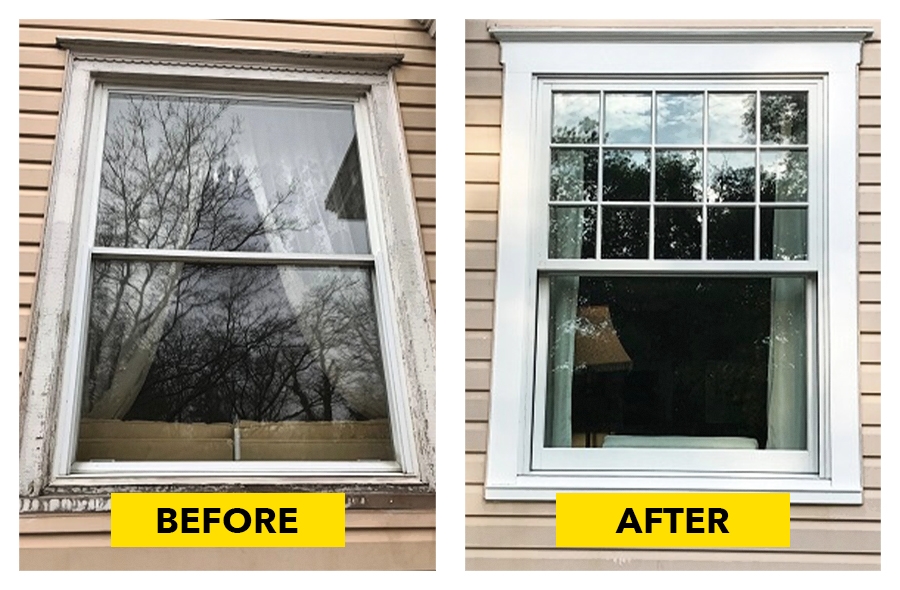Upgrade Your Home With Energy-Efficient Home Window Replacements
In the realm of home enhancement, the decision to update to energy-efficient home window replacements can significantly impact both the functionality and looks of a house (Spring window replacement). As property owners seek methods to enhance the performance and sustainability of their home, the option of home windows plays a crucial role in accomplishing these objectives. Beyond the surface degree of plain visual appeals, energy-efficient windows offer a wide range of advantages that surpass simple visual charm. With a cautious option procedure that considers numerous aspects, from glass kinds to setup techniques, getting started on this home upgrade trip could prove to be a transformative endeavor.
Advantages of Energy-Efficient Windows

The setup of energy-efficient windows offers substantial cost savings on utility expenses while boosting environmental sustainability. Energy-efficient home windows are developed to lessen heat loss and gain, minimizing the requirement for home heating and cooling down systems to work overtime. By properly shielding the home, these home windows assist preserve a comfy indoor temperature year-round, causing reduced power usage and reduced energy expenses. Additionally, energy-efficient home windows can assist control dampness degrees within the home, decreasing the risk of mold and mold development.
Past the financial benefits, energy-efficient windows add to environmental sustainability by decreasing carbon exhausts linked with power production. By reducing power usage, these home windows help reduce the ecological impact of illumination, home heating, and air conditioning domestic rooms. This decrease in energy usage plays an essential function in combating climate adjustment and advertising a greener future for generations ahead. Generally, buying energy-efficient home windows not only improves the comfort and efficiency of a home but also straightens with ecologically conscious practices.
Kinds Of Energy-Efficient Glass
Various innovative kinds of energy-efficient glass offer one-of-a-kind buildings that deal with various needs and preferences in improving the sustainability and efficiency of structures. Low-emissivity (Low-E) glass is a popular option made to reduce the amount of ultraviolet and infrared light that can go through the glass, thus lowering heat transfer. This kind of glass helps preserve a consistent indoor temperature level, reducing the requirement for heating or cooling systems, and ultimately lowering energy costs. Another ingenious choice is spectrally discerning glass, which permits noticeable light to pass via while obstructing particular sorts of infrared radiation. This aids in maintaining a comfy indoor setting while reducing warmth gain. Triple-pane glass, consisting of three layers of glass with shielding gas between them, supplies enhanced thermal insulation, making it highly energy-efficient. Furthermore, self-cleaning glass with a special finishing that damages down and loosens up dust when subjected to sunlight can reduce upkeep demands and keep windows looking tidy. Each kind of energy-efficient glass supplies distinct advantages, permitting house owners to pick one of the most suitable option based on their details needs and objectives.
Factors to Take Into Consideration When Picking
When considering energy-efficient home window substitutes, it is important to very carefully evaluate certain aspects that align with your sustainability purposes and desired power savings. The U-factor steps exactly how well the home window protects, with lower numbers suggesting better insulation, while the SHGC indicates the window's capacity to block warm from sunshine. heritage upvc windows By carefully assessing these aspects, you can pick energy-efficient windows that enhance convenience, decrease power expenses, and benefit the environment.
Setup and Upkeep Tips

Regular maintenance is crucial to maintaining the effectiveness of your energy-efficient windows. Inspect the weather-stripping and seals for any type of voids or splits and replace them if required to preserve the windows' energy efficiency. Woodlands window replacement.
On top of that, lube moving parts such as hinges and locks to ensure smooth procedure. By following these installation and upkeep tips, you can enhance the power effectiveness of your home and lengthen the life-span of your energy-efficient windows.
Cost-Benefit Analysis of Upgrading

Energy-efficient windows are designed to reduce warmth transfer, decreasing the need for heating and cooling local window repair down systems to burn the midnight oil. This can lead to substantial cost savings on power costs, particularly in regions with severe temperatures. Furthermore, energy-efficient home windows can improve the total value of your home, making it extra eye-catching to possible customers if you see it here determine to sell in the future.
When computing the cost-benefit evaluation, consider the potential financial savings on power costs, any kind of readily available incentives or rebates, and the life expectancy of the windows. While the preliminary price might be greater, the long-lasting cost savings and benefits of energy-efficient windows make them a smart financial investment for home owners wanting to boost their residential property's power performance and worth.

Final Thought
In conclusion, updating to energy-efficient window substitutes offers countless advantages such as reduced power usage, raised convenience, and expense financial savings. By selecting the suitable kind of energy-efficient glass and taking into consideration elements like structure material and setup, homeowners can make the most of the performance of their windows. Regular upkeep and correct setup are crucial for long-lasting efficiency. Generally, the cost-benefit evaluation of upgrading to energy-efficient windows shows that the first investment can bring about considerable savings in the future.
When considering energy-efficient home window replacements, it is crucial to very carefully evaluate details elements that line up with your sustainability goals and preferred power financial savings. The U-factor actions how well the window insulates, with lower numbers showing better insulation, while the SHGC shows the home window's ability to block warm from sunlight. By thoroughly assessing these aspects, you can choose energy-efficient home windows that enhance convenience, reduce power expenses, and benefit the setting.
While energy-efficient windows may have a greater in advance price compared to conventional home windows, the long-lasting benefits often outweigh the preliminary investment.In conclusion, updating to energy-efficient window substitutes supplies many advantages such as minimized power usage, boosted comfort, and price financial savings.
 Jaleel White Then & Now!
Jaleel White Then & Now! Daniel Stern Then & Now!
Daniel Stern Then & Now! Katie Holmes Then & Now!
Katie Holmes Then & Now! Lisa Whelchel Then & Now!
Lisa Whelchel Then & Now! Meadow Walker Then & Now!
Meadow Walker Then & Now!